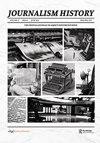Commercial Television’s Secret Goldmine: The Hidden Riches Generated by US Network TV News, 1960–1970
Q4 Social Sciences
引用次数: 0
Abstract
Network television news, in the United States, has been profitable since its inception. Yet network executives, scholars, and journalists continually repeat the myth that the commercial television networks historically provided news as a money-losing public service in the public interest. In testimony before the Federal Communications Commission (FCC) and Congress, in public relations materials, and in memoirs and interviews, network news employees asserted, and continue to claim, that sacrificing advertising revenue while absorbing the costs incurred in producing news programs proved networks operated in the public interest. Yet much evidence reveals the inaccuracy of such assertions. News programming on American television attracted significant advertising revenue from its inception in the 1940s, as the success of commercial news shows such as NBC’s Camel News Caravan and CBS’s Television News with Douglas Edwards (sponsored by Oldsmobile), proved. But TV news only matured into the most lucrative form of commercial television programming during the 1960s. That transformative decade began the year John F. Kennedy was elected president, and ended in 1970, when ten years of overall television advertising revenue growth plateaued as the American economy began to retrench. The decade was filled with sensational and historic events relayed—often live, through innovative new technologies—directly into the homes of the American citizenry. The American populace’s increasing TV news habit during the 1960s attracted a growing roster of advertisers and sponsors who funded the expansion of news divisions, an increase in news programs, and, ultimately, the growing profitability of network TV news. The crucial moment in American broadcast journalism’s commercial evolution occurred in November 1963 when President Kennedy was murdered in Dallas. The coverage of the assassination and the ensuing drama involving the president’s funeral, and the murder of presumed assassin Lee Harvey Oswald, riveted a remarkably high percentage of Americans to their television sets. The reliability and professionalism of broadcast journalism over those days intensified, and propelled, the burgeoning attraction of commercial sponsors to television news. Within two years, news would emerge as the most lucrative genre of broadcasting on the commercial airwaves—with top news shows generating more gross advertising revenue for the broadcasting corporations than entertainment or sport programming. This distinct aspect of American television’s economic history has been largely ignored in both scholarship and public commentary on TV news. Instead, the myth that news failed to earn corporate profits prior to the emergence of the CBS News program 60 Minutes in the商业电视的秘密金矿:美国网络电视新闻产生的隐藏财富,1960-1970
在美国,网络电视新闻从一开始就盈利。然而,电视网高管、学者和记者不断重复这样一个神话,即商业电视网在历史上提供新闻是为了公众利益而赔钱的公共服务。在联邦通信委员会(FCC)和国会的证词中,在公共关系材料、回忆录和采访中,网络新闻员工断言并继续声称,在吸收制作新闻节目的成本的同时牺牲广告收入,证明网络的运营符合公众利益。然而,许多证据表明这种断言是不准确的。美国电视台的新闻节目从20世纪40年代开始就吸引了大量的广告收入,NBC的《骆驼新闻大篷车》和CBS的《道格拉斯·爱德华兹电视新闻》(由Oldsmobile赞助)等商业新闻节目的成功证明了这一点。但电视新闻在20世纪60年代才成熟为最有利可图的商业电视节目形式。这一变革性的十年始于约翰·F·肯尼迪当选总统的那一年,结束于1970年,当时随着美国经济开始紧缩,十年的整体电视广告收入增长趋于平稳。这十年充满了耸人听闻的历史性事件,这些事件经常通过创新的新技术直接传播到美国公民的家中。20世纪60年代,美国民众日益增长的电视新闻习惯吸引了越来越多的广告商和赞助商,他们资助了新闻部门的扩张、新闻节目的增加,并最终推动了网络电视新闻日益增长的盈利能力。1963年11月,肯尼迪总统在达拉斯被谋杀,这是美国广播新闻商业发展的关键时刻。对暗杀事件的报道以及随后发生的涉及总统葬礼的戏剧性事件,以及被认为是暗杀者的李·哈维·奥斯瓦尔德被谋杀的事件,吸引了相当高比例的美国人观看他们的电视机。在那些日子里,广播新闻的可靠性和专业性增强并推动了商业赞助商对电视新闻的迅速吸引力。两年内,新闻将成为商业广播中最赚钱的广播类型,顶级新闻节目为广播公司带来的广告总收入将超过娱乐或体育节目。美国电视经济史的这一独特方面在学术界和电视新闻的公开评论中都被忽视了。相反,在哥伦比亚广播公司新闻节目《60分钟》出现之前,新闻未能赚取企业利润的神话
本文章由计算机程序翻译,如有差异,请以英文原文为准。
求助全文
约1分钟内获得全文
求助全文

 求助内容:
求助内容: 应助结果提醒方式:
应助结果提醒方式:


